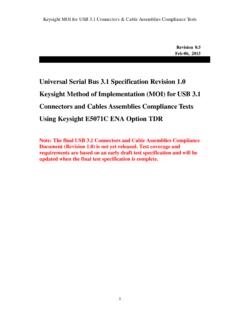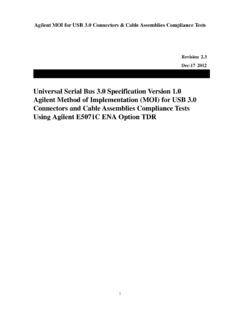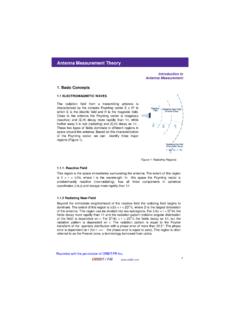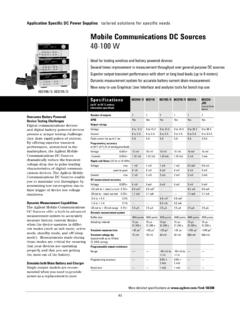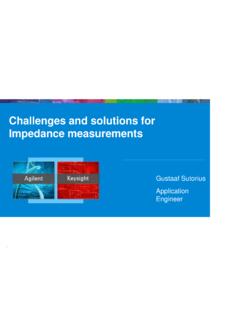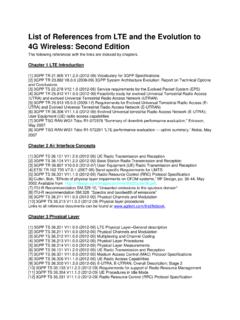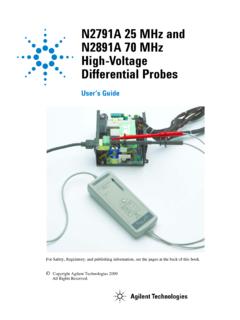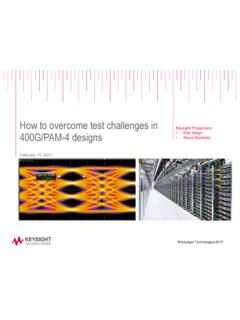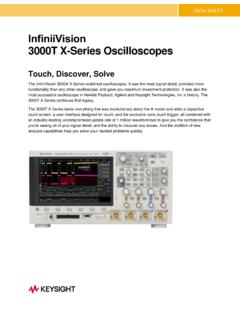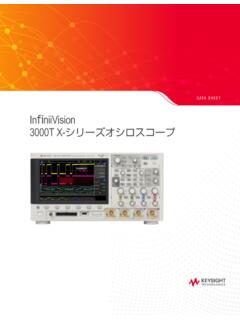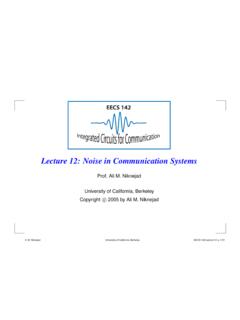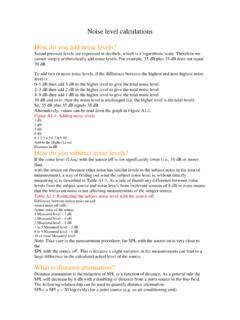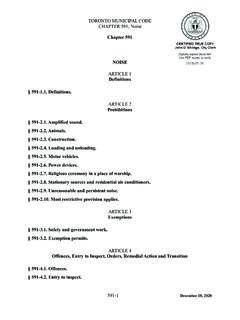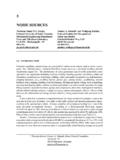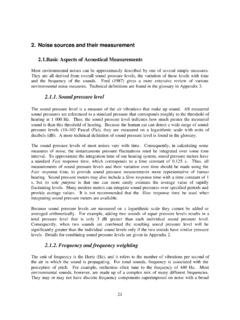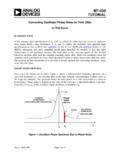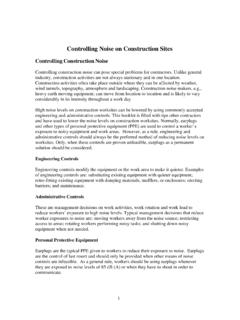Transcription of Overview on Phase Noise and Jitter - Keysight
1 Keysight EEsof EDA Overview on Phase Noise and JitterTechnical Overview02 | Keysight | Overview on Phase Noise and Jitter - Technical OverviewPhase Noise and Jitter are two related quantities associated with a noisy oscillator. Phase Noise is a frequency-domain view of the Noise spectrum around the oscillator signal, while Jitter is a timedomain measure of the timing accuracy of the oscillator period. This paper discusses the relationship between Phase Noise and Jitter in free-running oscillators. The reader is referred to three other papers for a more detailed look at the theory: Demir [1], Hajimiri [2] and Herzel [3].The Phase Noise and Jitter theory discussed here is mainly taken from these three papers. The Jitter in a closed-loop Phase -locked loop is not discussed here; see [4, 9, 10]. Phase Noise as a Lorentzian Spectrum We usually observe the asymptotic behavior of Phase Noise measured at an offset frequency f from the carrier and assert that:where a is some constant.
2 But this implies that Phase Noise goes to infinity at f=0. This is obviously wrong, as it implies that there is infinite Noise power at f=0. For very noisy oscillators, it could also suggest that > 0 dBc/Hz at small enough offsets. But Phase Noise has been shown to have a Lorentzian spectrum:where c is a scalar constant that describes the Phase Noise of the oscillator (in the absence of 1/f Noise and ignoring any Noise floor). This choice of expressing the characteristic constant as cfosc2 will become clear when the constant c is reused in the equations for Lorentzian spectrum nicely avoids any singularities at f=0 while maintaining the same asymptotic behavior. It also has the property that the total power in from minus infinity to plus infinity is 1. This means that Phase Noise doesn t change the total power of the oscillator, it merely broadens its spectral peak. If we borrow some terminology from laser technology (lasers are just optical oscillators), we can talk about the spectral line width of an oscillator (also half power width, full width at half maximum, or 3 dB width):(1)(2)(3)( )2221fcffaf osc ==( )()22221fcfcff oscosc+= cfffoscHWFWHM222 ==For quiet oscillators, the Phase Noise at offset frequencies greater than 1 Hz will always be less than 0 dBc/Hz, avoiding the embarrassing question of what a Phase Noise greater than 0 dBc/Hz means.
3 At some very small frequency less than 1 Hz, the Phase Noise will be greater than 0 dBc/Hz, but only within a bandwidth of a fraction of a Hertz. This is what we should expect, to see something representing the carrier signal itself at f=0, which in the absence of Noise would have a spectrum of d (f). The plot to the right shows the Phase Noise for f2 310 = cosc. We do see Phase Noise greater than 0 dBc/Hz, but only at an offset frequency less than Hz. The total power integrated over a 1 Hz bandwidth still | Keysight | Overview on Phase Noise and Jitter - Technical OverviewFor noisy oscillators, the Phase Noise will again always be less than 0 dBc/Hz, but this gives us a spectral line width that is greater than 1 Hz. The Phase Noise goes flat below fHW , showing the wide spectral line width of the oscillator due to high Phase Noise . (Note: this does not equate to the problem we have observed in the ADS Phase Noise simulation where the pnmx Phase Noise goes flat below some small offset frequency.)
4 The plot to the right shows the Phase Noise for f2 310 = cosc. Note if we were to extrapolate from the Phase Noise at 100 kHz, we would get a Phase Noise of +30 dBc/Hz at an offset frequency of 1 Hz. But this doesn t make sense that the Noise is stronger than the carrier. Instead the carrier is broadened over a kHz (two-sided) Noise as a Lorentzian Spectrum (Continued)3020100 10 20 30 40 50 60 70 80 Phase + + +020 10 20 30 40 50 60 70 80 90 100 Phase + + + + + +0604 | Keysight | Overview on Phase Noise and Jitter - Technical OverviewThis value varies with the observation time, and the variance of this measure diverges as t goes to infinity. This is not a very useful measure for free-running oscillators as it does increase with time. This measure is more often used with PLLs, because a PLL has a Phase reference source that resets the Jitter , which a free-running oscillator does not have. Another way of expressing the dependence on this form of Jitter on the measurement time is to express it as [1]:JitterWe intuitively know that Jitter is a variation in the zero-crossing times of a signal, or a variation in the period of the signal.
5 But a variation with respect to what? There are several different types of Jitter than can be defined [1,3]; they will subscripted them to distinguish between them. Jitter is a statistical measure of a noisy oscillation process. The period of each cycle of the oscillator is different, due to the Noise -induced Jitter . We will refer to n as the period of cycle n. For a free-running oscillator with Noise , the oscillation period will have a Gaussian distribution. This distribution has a mean avg, whose inverse can be defined as the average frequency of oscillation avgosc =f1. The distribution also has a standard deviation, which we will later define as the cycle-to-cycle Jitter sc. Jitter is defined as an rms jitterThe first type of Jitter is absolute, or long term, Jitter , sabs (t). This type of Jitter has an interesting property in that it is a function of time. It is given by the sum of each periods variation from the average:where c is the same oscillator Noise constant used in the Phase Noise formulations (2) and (3).
6 This Jitter accumulates over time in a free-running oscillator because any uncertainty in an earlier transition affects all the following transitions, and its effect persists indefinitely [2]. The sources of Jitter are normally assumed to be uncorrelated, both between devices and between successive observations of each oscillator period. The variances (s2) add for uncorrelated random variables.() = ==NnavgnavgabsNt1 (4)(5)()cttabs=2 05 | Keysight | Overview on Phase Noise and Jitter - Technical OverviewJitter (Continued)Cycle-to-cycle jitterThis is the Jitter definition that most people mean when they talk about Jitter as a single number. Herzel calls it cycle Jitter ; Demir and Hajimiri call it cycle-to-cycle Jitter . Other authors simply call it RMS cycle Jitter or the Jitter in one clock cycle. The cycle Jitter measures the variance of each period to the average period:This too can be defined in terms of the oscillator Noise constant c as well as in terms of the absolute Jitter :It describes the magnitude of the period fluctuations but contains no information on the longterm dynamics due to 1/f Noise .
7 If 1/f Noise modulates the Noise , the period will vary slowly and this form of Jitter will not display it. See section 4 for more discussion of 1/f Noise and Jitter . Herzel [3] defines another type of Jitter as cycle-to-cycle Jitter , in contrast to everyone else s use of this term for the Jitter sc defined above. Herzel s cycle-to-cycle Jitter measures the variance between successive periods. This is a measurement of the Jitter between successive periods:(6)(7)(8)() = = NnavgnNcN1221lim ()oscoscabscfcft===122 ()tftcoscabs22 =()2121221limcNnnnNccN = = =+ .06 | Keysight | Overview on Phase Noise and Jitter - Technical OverviewIn the absence of 1/f Noise in a region where the Phase Noise displays a 20 dBc/Hz slope, the rms cycle Jitter can be related to the Phase Noise by:Example: A 141 MHz oscillator has a Phase Noise of dBc/Hz at a 1 kHz offset frequency. This corresponds to a cycle-to-cycle Jitter of Phase Noise to Jitter (9)(10)( )232fff oscc =()322osccff f= 07 | Keysight | Overview on Phase Noise and Jitter - Technical OverviewwhereThis spectrum is called a Voigt line profile, for which there is no analytical expression.
8 It can only be analyzed numerically. The numerical analysis of this integral has not yet been implemented in ADS. It shares the property of the Lorentzian spectrum in that it has an integrated area of one: it conserves the overall power of the noiseless oscillator, and has a finite value as the offset frequency approaches zero. At small offsets the spectrum looks like a Gaussian when dominated by flicker Noise ; at larger offsets 1 f 3 behavior is seen, followed by 1 f 2 s [6, 7] mathematics is not as detailed as Herzel s, but he shows the derivation of the oscillator spectrum in the presence of flicker Noise . He, too, obtains a Gaussian spectrum at small offsets, but does not derive an expression for the full spectrum. The approach is not documented enough to implement in a simulator at this [8] also considers the spectrum due to flicker Noise . He first mathematically redefines 1/f Noise so it does not become infinite at f = 0, developing a stationary stochastic model for a process which is really nonstationary.
9 His mathematics are more complete but harder to follow; (75) in his paper gives a spectrum which is composed of a Lorentzian convolved with another complex spectrum. He derives approximations at f = 0 and f >> 0 , but does not consider the transition region between the Gaussian and Lorentzian previous discussions on Phase Noise and Jitter were derived assuming there were no colored Noise sources in the oscillator, such as 1/f Noise or burst Noise . The situation changes when 1/f Noise is added to an noisePhase Noise no longer displays a Lorentzian spectrum when 1/f Noise is present. There is no closed-form expression for the Phase Noise spectrum in the presence of 1/f Noise . The discussions so far have concentrated on the case where the transistor models do not have any flicker Noise . The analytical models of [1, 2, 3] and the Lorentzian spectrum were derived in the absence of flicker Noise . But any physical transistor exhibits flicker Noise , and this contributes to an increase in oscillator Phase Noise at small offset frequencies.
10 Flicker Noise is several orders of magnitude worse for MOSFETs than for BJTs. A BJT will typically display a flicker Noise corner frequency around 1 kHz, while in a MOSFET it will be around 1 MHz. Only in the last few years have analytical models for Phase Noise with flicker Noise been proposed [5 to 8]. Herzel [5] decomposes the model into a Lorentzian for the white Noise sources and Gaussian for the flicker Noise source. The final spectrum is then a convolution of a Lorentzian with a Gaussian spectrum. Using Herzel s notation:Colored Noise Sources(11)(12)(13)()[] [] = ,,42,,LGdSSPR vvvvNNLL[])(2exp21,22 GaussianG = [][ ])(1,22 LorentzianL + =08 | Keysight | Overview on Phase Noise and Jitter - Technical OverviewThese new approaches [5 to 8] present a potential model for solving the general problem of Phase Noise greater than 0 dBc/Hz when flicker Noise sources are present. Herzel s model [5] is most amenable to inclusion in ADS, but further research needs to be done.
